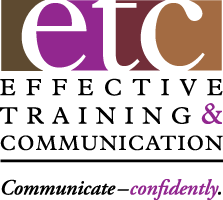(A reader favorite from my archive of the COSE ‘Mind Your Business’ eLetter.)
In his still frightening classic dystopian novel, ‘1984’, George Orwell invented ‘NewSpeak’, the official language of Oceania, used to control communication and thought.
So, let me pay homage to Orwell by inventing ‘CuSpeak’ in his honor, the official language we should always use when speaking to customers and prospects and not nearly as creepy as ‘NewSpeak’. While it’s much harder to learn than ‘SAE’ (Standard American English), it’s much more effective in influencing how they understand and view us.
Here are five reasons why resisting ‘CuSpeak’ is futile:
1. Reader-Centric
Too many small businesses still communicate with customers using a ‘writer-centric’ dialect. It’s what they speak and are comfortable using. But few, if any, customers speak their dialect. So, the result is often miscommunication or annoying the very people they want to influence.
Because ‘CuSpeak’ in totally reader-centric, it embraces Dr. Tony Alessandra’s ‘Platinum Rule’ concept and communicates with customers the way customers want to be communicated with. That’s the total opposite of their archaic ‘Golden Rule’ approach – communicating with customers the way they want customers to communicate back with them.
Using the ‘Golden Rule’ requires little assessment and no adaptation. ‘CuSpeak’ must be individualized, based on the specific customer’s industry background, organizational and educational level and preferred communication style. Mastering it demands time, effort and analysis – often in short supply with most small businesses.
2. Buzz word-Free
‘CuSpeak’ doesn’t use buzz words, because they may be too specific to the particular industry or small business. Instead, it prefers a simple word or phrase that clearly, consistently and universally has the same meaning as the buzz word.
If the airlines bought into this concept, they wouldn’t use the buzz word ‘deplane’ but the more universally understood ‘exit the plane’ or ‘leave’ Companies wouldn’t ‘escalate’ a problem, but ‘take it to the next level of (management or procedure)’. Lawyers wouldn’t ‘execute’ a contract, but simply ‘sign and date’ it.
3. Acronym-Free
Acronyms are words created from the first letters of a name, like ABBA (Agnetha, Bjorn, Benny, Annifrid) or group of words, like radar (radio detecting and ranging) that are pronounced as words. They’ve been around since the Roman Empire but came into popular use with the government or military, two institutions not known for effective customer communication. If you want to know for sure, look it up in the FAT (Federal Acronym and Terms) book. Really – I’m not making this up.
Your industry or business has lots of acronyms. So does your customer’s business, but they’re different. In ‘CuSpeak’, you minimize their use and always spell them out the first time. So, a marketing proposal may include BOGO (buy one get one) promotions, a pitch from an accountant might mention RITA (Regional Income Tax Administration) or a real estate development might mention NIMBY (not in my back yard). The parenthetical definitions take up minimal space and add subtle and convenient value.
Some words look like acronyms but are spoken as a string of letters, like FYI, R&D, Q&A, FAQ or GIF. While most of these are generally understood, you should define unusual ones by going beyond simply putting words to letter. For example, ‘B&HU’ (Best & Highest Use) means the best return on investment for your time or resources, ‘PBX’ (Private Branch Exchange) is teleco talk for switchboard and ‘EBITDA’ (Earnings Before Interest, Taxes, Depreciation and Amortization) refers to current operating profitability.
4. Vague-Free
‘CuSpeak’ is known for clarity. Simple, specific words rarely cause as much miscommunication for customers as vague references. So, opt for clarity wherever possible.
- ‘… by Friday at 5:00.’ is better than ‘… in a few days.’ or ‘… ASAP.’
- ‘… five complaints from three suppliers since Monday.’ is better than ‘… a lot of complaints from some customers lately.’
- If the project will cost $5,950, then say ‘$5,950’ instead of ‘about/around $5,900 ‘unless you need to indicate a range, like ‘$5,800 – $6,100’.
- Some vague references look like they’re hiding the truth. Isn’t ‘… over plan by 27.6% ‘clearer and more honest than ‘… more than a little bit over plan.’
5. Lame-Free
I use ‘Lame’ here to refer to ineffective style – using big words, wordy phrases or passive voice. ‘CuSpeak’ doesn’t allow any of that … and I’m so glad.
- So, ‘telephone’ becomes ‘phone’, ‘compensate’ becomes ‘pay’, ‘finalize’ becomes ‘finish’, and ‘modification’ becomes ‘change’ – all with no loss of clarity or meaning.
- Turn ‘fluctuation’ into ‘change’, ‘commence’ into ‘begin’ and ‘utilize’ into ‘use’.
- Instead of adding four words with ‘to the extent that’, only add one with ‘if’.
- Instead of ‘each and every one of you’, save three words with ‘each of you’.
- No need to say ‘… a check in the amount of $2,300.’ when ‘… for $2,300’ works better. And ‘… at this present point in time.’ Is no clearer than ‘… now.’
- Avoid the redundant ‘consensus of opinion’ when ‘consensus’ means the same thing. Why ever say ‘red in color’ when all we need is ‘red’?
- ‘CuSpeak’ loves Active Voice – it’s shorter, simpler and more conversational than Passive Voice. So, ‘The deadline will be determined.’ becomes ‘I/We/Anne will determine the deadline, ‘I/We/Hector will share the results Monday’ Is better than ‘The results will be shared Monday’ and ‘I/We/Sue appreciate(s) your help’ is more conversational than ‘Your help is appreciated’.
By now, it should be obvious that resisting ‘CuSpeak’ is futile and stupid. Embracing it is a great strategy for differentiating your business from the competitors who don’t get it yet. It’s well worth the time and effort to become fluent. So, try it and let me know how well it worked for you … and long live Big Brother!
